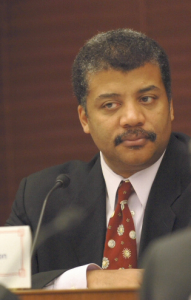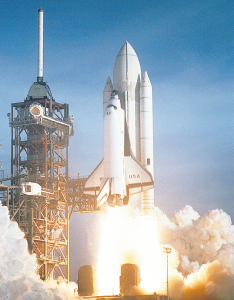WEDNESDAY, 3 OCTOBER 2012
Neil deGrasse Tyson is a rare individual. One of the leading astrophysicists in the world and a strong advocate for the importance of space exploration and scientific ambition in the American cultural landscape, he has also crossed over to the more public sphere to become one of the most recognised scientists of today, inspiring a whole new generation with the wonders of space science.Much like the stellar bodies he works with, Tyson is seen very differently depending on your point of view. He is regarded as a major thorn in the side of the US Senate, due to his continued demands for increased NASA funding. In popular media, he is a science star, with numerous appearances on late night talk shows such as The Daily Show with Jon Stewart or Real Time with Bill Maher. You might even join Sheldon Cooper in The Big Bang Theory by controversially accusing him of killing Pluto, after he played a key role in downgrading it from planet to dwarf planet. In every case, Tyson is a force to be reckoned with, an eloquent, passionate voice for renewing our love of “dreaming for tomorrow”.
Tyson was born on 5th October 1958 in Manhattan, the very same week, in which NASA began operations as a civilian space agency. Tyson has been reported as saying that he feels his life and NASA’s are twinned somehow, tied to the same fate. His interest in space and astrophysics was sparked on a family visit to the Hayden Planetarium in Manhattan – of which he is now a Director – when he was nine years old. Growing up in the Bronx, Tyson was never exposed to a night sky full of stars, and upon seeing the thousands of lights on the ceiling of the Planetarium he described it as a “nice hoax”. It wasn’t until another family trip took him to Pennsylvania that his worldview was fatefully altered. Upon seeing the heavens properly for the first time, Tyson was struck by it, saying from then on that it was as if “I had no choice in the matter, the universe called me”.
Tyson was soon determined to make astrophysics his life’s work. He studied Physics at Harvard before beginning a Masters course at the University of Texas. He went on to gain a PhD in Astrophysics from Columbia University in 1991.
Tyson’s journey towards academic success was far from easy – in his PhD Convocation Address at Columbia, Tyson recalls his personal experience at the University of Texas, where colleagues assumed that he had a better chance of a career in basketball or business, but never astrophysics. The colour of his skin meant that nobody questioned his athletic prowess, but when it came to science, “my academic failures were expected, and my academic successes were attributed to others”. Thankfully, his scientific talents were more welcomed at Columbia, and after finishing his PhD, he went on to hold an academic position for three years at Princeton University, before moving back to the place where his interest in the cosmos was first sparked: the Hayden Planetarium. He has remained there ever since and is currently the director of the facility, which was renamed the Rose Centre for Earth and Space in 2000.
It was during his Directorship that Tyson was involved in the controversy regarding the classification of Pluto as a planet. In February 2000, while designing new exhibitions for the Centre, Tyson and his team created a system that taught people about the common and distinguishing features of each object in the Solar System, not just the planets, but all objects that orbit the sun, from moons to asteroids. Having carefully gathered information from many leading academics, they designed an exhibition that classed Pluto with other objects of the Kuiper Belt (a region extending beyond the orbit of Neptune comprised of many small icy bodies) and not as a planet. The reason for this change was the discovery of many new Pluto-like objects in the Kuiper Belt making it clear that Pluto is not unique and has much more in common with these other objects than with the planets.
One year later, the New York Times ran a headline that read “Pluto not a planet…only in New York,” which drew upon Tyson’s new model and started a flood of requests from media, academia and the public for Tyson to defend his decision. His model even incited hate mail from those, outraged at the perceived demotion of Pluto.
Tyson has even been accused of having some form of personal vendetta against Pluto despite the fact that the decision merely reflected the most up to date scientific wisdom. This conclusion was validated when the International Astronomical Union (IAU) officially reclassified as a Pluto ‘dwarf planet’ in 2006. Pluto became the archetype of this new classification, which currently includes five known examples, with at least another 50 thought to exist within the Solar System.
In 2001, Tyson began working with NASA when he was appointed by President Bush to the Commission on the Future of the US Aerospace Industry. He subsequently joined the Presidents Commission to Implement the US Space Exploration Policy, which then called for manned and robotic missions to the “Moon, Mars and Beyond,” he was instrumental in helping to modify this policy and set more practical goals for the near future. More recently he accepted a key role in NASA’s Advisory Council, of which he is now the Chairman. In 2011, Tyson was awarded the NASA Distinguished Public Service Medal, the highest civilian honour bestowed by NASA, in recognition of his years of work.
His prominent academic standing has helped Dr Tyson to develop his interests in science communication and outreach. He regularly appears on television and radio, and has written several books targeted at a general audience in addition to his essays for the Natural History Magazine. His writings cover aspects of astrophysics and cosmology, but also reflections on the place of science and religion in society. He is especially outspoken about the danger that the teaching of Intelligent Design could have on scientific discovery. He says that he doesn’t want students to be taught that anything they don’t understand is divinely constructed and therefore outside their capacity to observe and infer.
Tyson continues to be an outspoken supporter of increasing funding for NASA. By promising further space exploration, he hopes to ignite a new dream in the collective mind of both the US and the rest of the world. He is fighting an increasingly difficult battle to remind the public of why NASA is important. NASA funding is reduced with every passing year, forcing ambitious programs such as manned flights to Mars by 2020 to be abandoned only five years after their inception. Tyson therefore calls for a doubling in taxpayer funding, so that NASA can once more reach for the stars. Crucially, he points out that an audacious and visible space program will inspire the next generation to become scientists and engineers. One man’s dream of tomorrow, combined with the passion and drive to see these dreams realised may help to secure the foundation for the next great era of space exploration – the legacy of a life inspired by the night’s sky itself.
Matthew Dunstan is a 1st year PhD student in the Department of Chemistry


